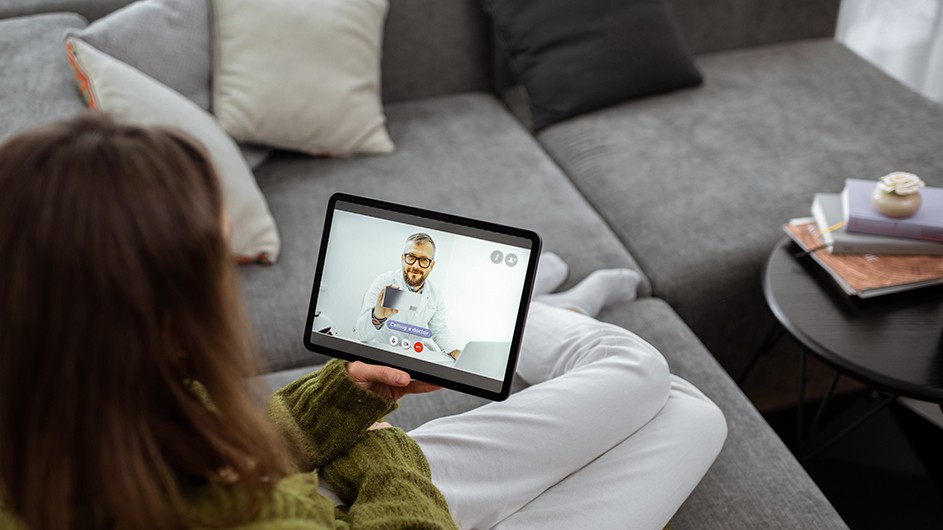Managing Eating Disorders During COVID-19
Concerned about relapse and maintaining recovery, practitioners and patients are embracing teletherapy now that face-to-face sessions are less of an option.

Many of us have turned to comfort food to cope with the pandemic and its resulting restrictions, but people with eating disorders face an array of new challenges that can disrupt coping strategies and pose a risk to recovery.
"Isolation, altered routines and the stress of grocery shopping are just a few of the destabilizing effects that the coronavirus can have on those with both overeating and undereating issues," said Michael Devlin, professor of clinical psychiatry at Columbia University Irving Medical Center (CUIMC) who specializes in eating disorders.
People who experience binge-eating episodes may be driven to buy large quantities of groceries prompted by a fear of food shortages and social distancing guidelines to limit trips to the store.
Others stuck at home with stockpiles of food may further restrict what they eat. And for those who rely on exercise, such as classes at a gym or sessions with a trainer, to stave off anxiety, the disruption of those routines can trigger disordered eating and risk of relapse.
The escalation of eating disorders during the coronavirus pandemic is worrisome, given that 20 million women and 10 million men—10 percent of the population in the United States—suffer from anorexia nervosa, bulimia nervosa, binge eating disorder and related conditions. Eating disorders have the highest mortality rate of any mental illness, and occur throughout the lifespan in people of diverse ethnicities.
A large-scale international study analyzing the early impact of COVID-19 on eating disorders found that more than two-thirds of participants surveyed reported fears over the worsening of their disorder and were concerned about their ability to maintain recovery.
Pros and Cons
With face-to-face therapy considered risky, the concerns over relapse have motivated patients and practitioners to turn to teletherapy. It is an option rarely used as a sole means of treatment before the pandemic because it prevents the use of visual cues, such as body language or facial expressions, to guide the session.
Clinicians who specialize in eating disorders are delving into telehealth research and sharing notes on how to make the most out of sessions. And, they are finding that connecting with patients online is surprisingly effective.
“If there is a silver lining, it is that therapists have expanded their use of teletherapy and are coming up with creative solutions to adapt treatments to an online format,” said Deborah Glasofer, associate professor of clinical psychology at CUIMC, who before the pandemic engaged in online therapy mainly with patients on business trips. “Teletherapy doesn’t replace therapy in a room—it is a bit of a different thing,” she said, “with challenges but also opportunities.”
One of the hurdles is that eating disorders often go hand in hand with negative body image. “Patients overvalue and often overestimate body size, and video formats may heighten their awareness both of being seen and of seeing themselves,” Devlin said.
While avoiding video altogether isn’t advised, there are other solutions to alleviate a patient’s discomfort, such as moving back from the camera and changing settings to minimize the on-screen image. For some patients, exploring negative feelings around online sessions can be useful in treatment, said Glasofer, who has assembled data, recommendations and resources to help practitioners in her group treat patients through the pandemic.
Innovating Care
Much of the existing material is geared to practitioners of cognitive-behavioral therapy (CBT), considered the leading, evidence-based treatment for eating disorders. This approach, employed by both Glasofer and Devlin in their practices, helps individuals to understand the interaction between their thoughts, feelings and behaviors and develop strategies to change negative thinking patterns to improve mood and functioning.
Clinicians have discovered that a number of CBT strategies can be adapted to online treatment. These may include scheduling virtual sessions over food preparation and meals; using screen sharing to help patients fill a grocery cart through an online delivery service and brainstorm alternative foods; or asking patients to show their image on screen, detailing anxiety levels and identifying emotions.
One of the obstacles to teletherapy in the past has been the reluctance of insurance companies to pay for the sessions. That barrier has been lifted, at least temporarily. During COVID-19, state and federal regulatory agencies relaxed rules on coverage for telehealth services, treating remote sessions in the same way they do traditional office visits, with insurance companies following suit.
Some patients are finding they prefer virtual visits mainly for the convenience. Therapy from home allows people with transportation difficulties, physical limitations or young children easier access to care. And clinicians are taking their cues from their patients.
“Six months into this, I would say I’ve been impressed by the ability of my patients to adapt to changing circumstances and carry the work forward,” Devlin said. “The pandemic has forced great change in the practice of health care, and I wouldn’t be surprised to see virtual sessions or some combinations of in person and videoconferencing become part of norm."